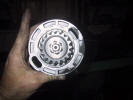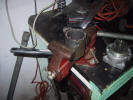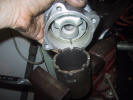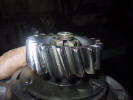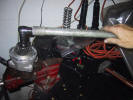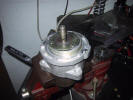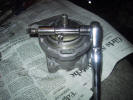
Left side view of bike showing alternator just under
gas tank. |
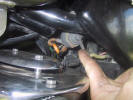
Begin the removal process by turning off the battery
master switch (if installed) or disconnecting the battery. If you
don't, you may end up welding a wrench to the bike! |

Remove the side cover if installed...most just pull
off. |
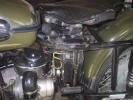
Now, the air cleaner housing can be removed. |
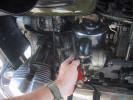
Pull the breather hose free... |

...of the housing. |

Use a screwdriver to loosen the upper and... |
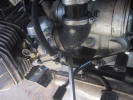
...lower branch tubing clamps... |
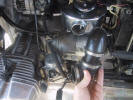
...and remove both the left and right tube
assemblies. |
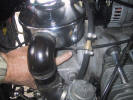
On the right side of the housing, use a 13mm
wrench/socket to remove the nut/washer holding the clutch cable
bracket. Not the nut on the clutch adjustment
screw...but the nut farther back securing both to the engine
case. |

Next, remove the top bolt on the starter which
secures the left side of the air cleaner housing bracket. |
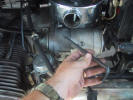
Use the 8mm Allen wrench for this. I like the type
with the ball end as they are easier to use. |
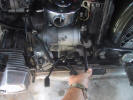
Depress the kick start lever so it is out of the way.
Hold it down with your foot or use a bungee cord. |

If you have trouble breaking the starter bolt free,
use a ratchet extension as a cheater bar. |

With the two fasteners removed, the filter housing
can now be eased out the left side. This is a good time to clean the
air filter. |

The alternator now has enough clearance to be
removed. |
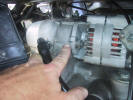
Before removing the alternator, mark the engine case
and alt. housing so the original position can be maintained upon
reassembly. I use a indelible ink pen. |
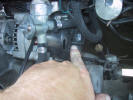
Pull the male spade... |

...out of the back of the alternator. |
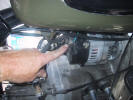
Use a 10mm wrench to remove the nut... |
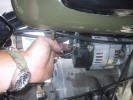
...holding the wires on the post. |

Remove the right... |

...and left alternator mounting nuts using a 17mm
wrench. |

The alternator can now be eased off its mounting
studs. Use care not to tear the paper gasket underneath. If damaged
you can make a new one from a brown paper bag. Use some silicone
grease on both sides of the gasket to prevent it from sticking next
time. |

The alternator can now be easily slipped out.... |

...the right side between the bike and sidecar.
|
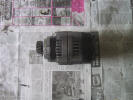
Just a couple views... |
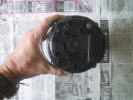
...backside... |
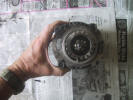
...front side. |

These are 4 bolts that need to be removed to split
the alternator. I'll do a further tear down later in another
section. For right now I'm just going to change out the oil seal
which is leaking. A very common problem. |
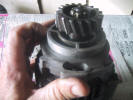
You can just see the seal under the gear. The oil
keeper spring is visible through the fuzziness. |

To remove the seal the gear must come off first.
Start by removing the cotter pin... |
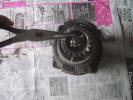
...use the needle nose pliers to straighten the pin
arms... |
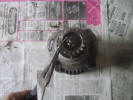
...and pull it free. |

Clamp the needle nose Vise Grips around the shaft of
the gear, use the 19mm socket, ratchet and breaker on the bolt.
Stand on the alternator body and turn the nut off. |
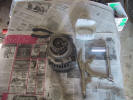
Easy smeezy. |

Attach a 3 arm puller to the gear. You will need a
lead screw shaft protector (seen between the gear and screw) for the
screw tip as the alternator gear shaft is not center drilled. |

Hold the puller and turn the lead screw using the
13mm socket and ratchet. |

The gear should come off smoothly will very little
effort. If not, something is wrong or you are not using the right
size puller. Watch for the gear key, it
usually stays on the shaft. |
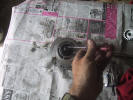
Use a long thin blade screwdriver to pop the seal
free. Notice it is installed face down. Be
careful to not gouge the alternator seal housing with
whatever you use to remove the seal. |
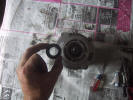
This seal is a standard 20X40X10mm seal available
anywhere. |

Get a good aftermarket brand seal. It is more common
to find a 20X40X7 seal. |
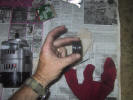
The 7mm deep seal will work just fine. Just seat it
so it is at the same depth as the original.
This means, do not seat it all the way
down. |
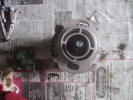
I put a little silicone grease on the inner lip of
the seal. My bearing supply guy says this makes it wear in better
and last longer. |
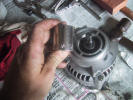
Use an appropriate size driver to set the seal. Here
I used a 1 & 1/8th's socket. A deep socket would have work better
due to the base hitting the key which I left on the shaft. |

Gently tap around the base of the socket to evenly
seat the seal. Remember! If using the
7mm thick seal instead of the original 10mm thick seal; seat the
seal to the same depth which is the top of the bevel in the
race/housing. |
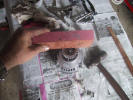
Install the gear by using a block of wood... |
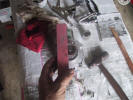
...to tap around the face of the gear... |
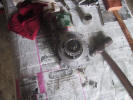
...so it is driven evenly onto the shaft until it is
fully seated. |
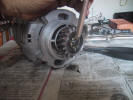
Use a new beefy cotter pin, not some tiny POS. If the
cotter pin comes off; the gear will come loose and take out your
timing gears. Tap the new cotter pin in using a tommy bar and
hammer. |

Bend the cotter pin arms with a pair of needle nose
pliers and tap the arms down tight against the nut with tommy bar
and hammer. |
The alternator is now
ready to be reinstalled in the reverse order of removal.
If you didn't mark the position before removal or you
want to adjust the gear lash by "ear"...the following is how it is
done.
|
1. Install the
alternator and rotate it CW to the stop (as seen from the rear),
then rotate it CCW .12 to .15 inches/ 3 to 4 mm (measured at the
outer diameter of the alternator frame). |
2. Secure the
alternator in this position. Start the engine and listen to the
alternator gear mesh. Stop the engine, rotate the alternator
slightly, secure it, and start engine again. With incremental
adjustments of the alternator position, the gear noise may be
minimized which will signal the correct position. |
If you have the
engine out of the frame and the front cover off; use a dial
indicator and stand to measure the gear last to .002 to .004 in at
least 4 different positions and then secure alternator and recheck
lash. |



